Buying Property Abroad
Montenegro: The Rising Star of European Property Investment
The allure of Montenegro as a prime property investment destination is undeniable, but what unique opportunities await savvy investors? Discover more inside.

Montenegro is rapidly emerging as a top choice for property investment in Europe. With property values rising by 9.09% in 2023 and average prices around €1,500 per square meter, it's more affordable than many Western markets. The tourism sector, contributing considerably to the economy, drives demand for coastal properties, which offer impressive rental yields. Plus, favorable tax rates and tourism growth make this an attractive opportunity. However, some legal and regulatory hurdles exist, so staying informed is vital to navigate the market. By exploring further, you can uncover more insights about potential investments in this stunning destination.
Key Takeaways
- Montenegro's property values surged by 9.09% in 2023, with average prices around €1,500 per square meter, making it attractive compared to Western Europe.
- The country's projected economic growth of 3.7% in 2025 and 5.67% in the real estate market from 2025 to 2029 signals a stable investment environment.
- High rental yields, especially in coastal areas like Budva (6.60%), underscore strong income potential from tourism-driven property investments.
- Modern amenities, including smart home technology and wellness facilities, are in high demand, enhancing property appeal and market value.
- Prime investment locations like Budva, Tivat, and Kolašin offer unique opportunities, supported by ongoing infrastructure development and tourism growth.
Overview of Montenegro's Real Estate Market

Montenegro's real estate market has shown impressive growth, with property values climbing by 9.09% in 2023. You'll find that the average price per square meter hovers around €1,500, making it a more affordable option compared to many Western European markets. This affordability is coupled with strong rental yields, offering net rental incomes that can reach up to 8% per year. Additionally, the market has become increasingly attractive to investors due to the average property value increase over the recent years.
Whether you're looking for a cozy apartment starting at EUR 50,000 or a charming house from EUR 125,000, the market caters to diverse budgets and preferences.
The surge in tourism, particularly among remote workers and retirees, is fueling demand for both vacation rentals and permanent homes. Coastal hotspots like Budva, Kotor, and Bar are particularly popular, thanks to their beautiful scenery and vibrant lifestyle.
Additionally, as Montenegro moves closer to EU accession, you can expect enhanced stability and economic growth, attracting more foreign investment. With a range of property types—from luxurious coastal apartments to traditional stone houses—you'll find plenty of options to suit your taste and investment goals.
Projected Market Growth and Trends

As the real estate market in Montenegro continues its upward trajectory, projected growth and emerging trends signal an exciting future for investors. With a projected economic growth rate of 3.7% in 2025 and a robust expansion of the real estate market by 5.67% from 2025 to 2029, Montenegro is becoming increasingly attractive.
Here are three key trends to reflect on:
- Rising Property Values: In 2023, property values increased by 9.09%, with expectations of continued growth driven by tourism and economic development. The introduction of progressive property tax in 2025 is expected to further influence the market dynamics.
- Stable Rental Yields: Rental yields are climbing, with potential net rental incomes reaching up to 8% per year in prime locations, thanks to a resurgence in tourism.
- Luxury Market Demand: There's a noticeable demand for high-end residential complexes and luxury hotels, particularly in coastal areas like Budva and Tivat.
These trends, combined with a favorable investment climate and Montenegro's enhanced global visibility, create a promising landscape for property investors looking to capitalize on future opportunities.
Customer Preferences in Property Buying

When you're considering property in Montenegro, modern amenities are likely high on your wishlist. Many buyers want homes that blend nature with contemporary living, offering both comfort and stunning views. Plus, smart home technology is becoming a must-have, making your investment not just stylish but also efficient. Additionally, properties in coastal areas typically attract higher interest due to their scenic locations and proximity to the sea.
Modern Amenities Demand
In today's property market, buyers increasingly prioritize modern amenities that enhance their lifestyles and streamline daily tasks.
The demand for these features isn't just a trend; it's a fundamental shift in what you expect from your living space. As you consider investing in Montenegro, keep in mind that modern conveniences can greatly elevate your living experience.
Here are three key amenities that are in high demand:
- High-speed internet and smart home technology: These are essential for both work and leisure, allowing you to stay connected and manage your home efficiently. Safety and security features like gated access and surveillance are also becoming increasingly vital for potential buyers.
- Fitness centers and wellness facilities: Access to these amenities promotes a healthier lifestyle, making it easier for you to prioritize your well-being without leaving the property.
- Energy-efficient appliances: These not only reduce your utility bills but also align with a growing preference for sustainable living.
Nature-Integrated Living Spaces
Embracing nature-integrated living spaces is becoming a priority for many property buyers today.
You're likely drawn to biophilic design elements that maximize natural light and outdoor views. Large windows and skylights not only brighten your space but also enhance your connection to the outdoors. Incorporating indoor plants can improve air quality and add a touch of liveliness to your home, making it feel more inviting. Additionally, the design can harmonize with the surrounding environment, allowing you to enjoy the soothing sounds of waves and wind from nearby coastal areas.
You'll also appreciate the use of natural materials in construction, which creates a seamless link to nature. Features like green roofs and living walls not only enhance aesthetics but also provide insulation and improve air quality. The presence of these elements can lead to increased property values, making your investment even more appealing.
Additionally, soothing water features, such as fountains, can create a calming environment that promotes relaxation.
Beyond aesthetics, these spaces offer significant health benefits. Exposure to nature has been shown to reduce stress, boost concentration, and even improve overall physical and mental well-being.
The growing demand for these properties means they often command higher market values and attract better rental yields, making them a smart investment choice for you.
Ultimately, choosing a nature-integrated living space aligns with your desire for a healthier, more sustainable lifestyle.
Smart Home Technology
As technology continues to advance, smart home features are quickly becoming a must-have for today's property buyers.
If you're looking to invest in Montenegro, understanding these preferences could greatly influence your decision. Properties equipped with smart technology not only sell faster but can also boost the property value by up to 5%.
Buyers increasingly prioritize smart features for several reasons:
- Enhanced Security: Smart security systems like video doorbells and automated locks provide peace of mind, especially desirable for women who heavily value safety. Additionally, features like air purifiers can contribute to a healthier living environment.
- Energy Efficiency: Smart thermostats and energy-efficient appliances help reduce utility bills, appealing to eco-conscious buyers and investors alike. In fact, over 40% of Americans purchase smart devices for improved energy efficiency. Incorporating energy-efficient technology in properties can further enhance their marketability.
- Modern Convenience: Integrated smart systems enhance the overall appeal of a property, making it more attractive to millennials and Gen Z who seek modern living solutions.
Investing in a property with these smart features can future-proof your investment, ensuring it remains competitive in the market.
With the growing demand for security and energy-efficient solutions, incorporating smart home technology is an intelligent move for any property buyer in Montenegro.
Impact of Tourism on Property Demand

Tourism in Montenegro is driving a surge in property demand, making it an attractive option for investors like you.
With the rise in tourist arrivals, high rental yields are becoming commonplace, particularly in popular areas. This growing market presents lucrative opportunities for those looking to capitalize on the booming tourism industry. Moreover, the expanding tourism industry boosts rental income potential for investors, with peak seasons seeing significant visitor influx.
Tourism-Driven Property Demand
With a remarkable surge in tourist arrivals, Montenegro's property market is experiencing a transformative shift driven by the demand for accommodations. In 2022, the country welcomed over 2.1 million visitors, a 30.7% increase from the previous year. This growth has created a significant demand for various types of accommodation, particularly in coastal hotspots like Budva and Herceg Novi.
Here are three key factors driving this tourism-based property demand:
- Preference for Coastal Living: 83% of visitors choose seaside resorts, emphasizing the need for properties near the water with stunning views.
- Rising Real Estate Prices: As tourism flourishes, property prices have surged, with coastal areas experiencing some of the highest increases—Budva properties can range from €1,700 to €10,000 per square meter.
- Focus on Luxury Developments: Investors are increasingly drawn to high-end residential complexes and luxury hotels to cater to the influx of tourists seeking premium experiences.
Additionally, the residential real estate segment is projected to dominate the market, expected to reach a volume of US$18.16bn by 2025.
This combination of rising visitor numbers and high demand for accommodations makes Montenegro a hot spot for property investment, setting the stage for exciting opportunities in the real estate sector.
High Rental Yields
The surge in tourist arrivals in Montenegro hasn't only driven property demand but also markedly boosted rental yields. Currently, the average gross rental yield stands at 5.61% for Q3 2025, slightly down from 5.95% in the previous year. However, specific cities showcase even higher returns. In Budva, for instance, you can expect an impressive 6.60% gross rental yield, while Tivat offers a solid 5.57%. If you're looking at Podgorica, the city center yields around 5.4%, yet a 3-bedroom apartment can reach up to 6.07%. Outside city centers, yields remain competitive, averaging 5.62%. This means that whether you invest in a studio or a larger property, you're likely to see favorable returns.
It's vital to note that net yields typically fall 1.5% to 2% lower than gross figures. However, with recent drops in property prices and a growing demand for rentals, many investors anticipate yields could reach between 6-8%. Additionally, the overall yield for Podgorica apartments stands at 6.67%, highlighting the city's potential for lucrative investments. Montenegro's thriving tourism scene guarantees that your investment remains a lucrative opportunity in the European property market.
Government Initiatives for Foreign Investors

Montenegro's government actively encourages foreign investment through a robust legislative framework designed to eliminate barriers and enhance investor confidence. The Foreign Investment Law is particularly supportive, offering you nearly the same rights as domestic investors, with minimal restrictions.
This law provides several key advantages:
- Protection Against Expropriation: You'll enjoy guarantees against expropriation, ensuring your investments are secure.
- Tax Incentives: A flat personal income tax rate of just 9% applies to property rental income, making it financially attractive. Additionally, capital gains tax can be considerably reduced or even exempted based on ownership duration.
- Simplified Processes: The government has streamlined property acquisition for non-residents, minimizing bureaucratic hurdles and fostering an easier buying experience. Furthermore, the average annual property price increase of approximately 5-10% over the last decade highlights the strong investment potential in the region.
With regular updates to the Investment Incentives Inventory, you'll find that the government continually enhances its offerings.
This includes financial and non-financial support across various sectors, such as tourism and sustainable development. By choosing to invest in Montenegro, you're not just gaining property; you're entering a supportive environment that prioritizes foreign investors' interests.
Economic Stability and Investment Climate

Investors are likely to find Montenegro's economic stability and investment climate appealing, especially after the remarkable recovery from the pandemic. The country posted impressive GDP growth of 14% in 2021 and 6.9% in 2022, indicating a robust rebound. Private consumption and a thriving tourism sector have driven this growth. Though Montenegro faces challenges like high public debt, its ratio has decreased from 105% in 2020 to around 73% in 2023. Additionally, the country's key economic driver is tourism, which contributes approximately 25% to GDP.
The political landscape remains somewhat unstable, impacting the investment environment. Despite frequent government changes since 2020, the "Europe Now" program aims to bolster economic reforms. The favorable tax regime, including a low corporate tax rate of 9% and no capital gains tax on real estate sales, enhances the appeal for foreign investors.
Here's a snapshot of Montenegro's economic indicators:
| Indicator | Value |
|---|---|
| GDP Growth (2021) | 14% |
| Public Debt-to-GDP Ratio | 73% (April 2023) |
| Corporate Tax Rate | 9% |
With these factors in mind, Montenegro stands out as a promising destination for property investment.
Key Investment Opportunities

When considering key investment opportunities in Montenegro, you'll find both coastal properties and inland retreats offer unique advantages.
Coastal investments, particularly in popular areas like Budva and Kotor, attract tourists and promise high rental yields. The thriving tourism sector significantly boosts the demand for rental properties, making it an attractive investment avenue.
Meanwhile, serene mountain locations provide a tranquil escape, appealing to nature lovers and those seeking a quieter lifestyle.
Coastal Property Investments
Coastal property investments in Montenegro offer enticing opportunities that can greatly enhance your investment portfolio. With stunning locations and a booming tourism industry, you can find lucrative options that cater to various budgets and preferences. Additionally, Montenegro’s close proximity to the Croatia real estate market also adds to its appeal. With increasing interest from international buyers, now is an opportune time to consider investing in coastal properties in Montenegro. The potential for long-term growth and high returns makes it a wise choice for savvy investors looking to diversify their real estate portfolio.
Here are three prime areas to evaluate:
- Budva Riviera: Residential properties range from €1,700 to €3,500 per sq. m for flats, while luxury apartments can go from €3,500 to €6,000 per sq. m. Houses and villas can reach €10,000 per sq. m.
- Tivat: Home to Porto Montenegro, this area attracts international buyers looking for luxury and exclusivity within the breathtaking Boka Bay.
- Lustica Bay: This emerging area offers modern amenities, private beaches, and a marina, making it an attractive investment for those seeking a unique lifestyle. Additionally, the coastal region average price reached €2,107/sq. m in Q2 2025, reflecting the growing demand for properties in this picturesque area.
With strong economic growth, political stability, and a favorable tax regime, Montenegro is a safe bet for your investments.
Plus, the potential for significant rental income from tourists can further boost your returns. Don't miss the chance to capitalize on this rising star in European property investment!
Inland Retreat Opportunities
Have you considered the potential of inland retreat opportunities in Montenegro? The country's mountainous regions, like Kolašin, Žabljak, and Nikšić, offer unique investment options that blend natural beauty with lifestyle appeal.
Kolašin, known as Montenegro's ski capital, features the award-winning Terra Homes development and boasts 45 km of world-class ski trails. With a €700 million investment in tourism, properties here start at €750,000, making it a promising venture. This growth is further fueled by NATO membership, which has spurred foreign investments.
In Žabljak, located within Durmitor National Park, you'll find a haven for both hikers and skiers. While the real estate supply is high, the shorter ski seasons can pose liquidity challenges.
Nikšić, just 90 minutes from the coast, offers a balance of urban amenities and rural charm, though it lacks major real estate developments.
Challenges in the Property Market

Maneuvering the challenges in Montenegro's property market can be intimidating for investors. Legal complexities, market volatility, and bureaucratic hurdles require your attention.
First, you should be aware of the following:
- Legal and Regulatory Challenges: The legal framework can lack transparency, with ambiguous laws affecting property ownership. Foreign ownership comes with restrictions, requiring you to understand the necessary permits and licenses.
- Market Volatility and Economic Risks: Property prices can fluctuate considerably due to economic conditions and political stability. Past global financial crises have led to declines of 20 to 30 percent, highlighting the risks of market oversaturation and a potential bubble. Additionally, the increasing interest from international visitors has contributed to rising rental yields, which can impact market stability.
- Bureaucratic and Administrative Challenges: Acquiring property can be a time-consuming process filled with paperwork and permits. Patience is essential, and partnering with a competent lawyer can ease the navigation of these bureaucratic procedures.
Popular Locations for Property Investment

Despite the challenges in Montenegro's property market, certain locations stand out as prime investment opportunities. If you're considering property investment, Budva is a must-see. Known for its beautiful Old Town and sandy beaches, it attracts tourists and buyers alike with its mix of historical and modern properties.
Tivat is another hotspot, featuring a luxury marina complex and upscale waterfront developments, making it appealing to high-net-worth individuals. Additionally, property prices in Tivat vary significantly based on location and property type, with apartments starting from €275,000.
Herceg Novi offers a quieter alternative, with its medieval fortresses and therapeutic mud baths. The areas of Igalo and Meljine showcase natural beauty and a laid-back atmosphere.
If exclusivity is what you seek, Sveti Stefan boasts breathtaking views and high-demand waterfront properties.
Kotor, a UNESCO World Heritage Site, captivates with its stunning bay views and well-preserved architecture. For a picturesque experience, Morinj provides modern real estate options near dreamy landscapes.
Finally, Donja Lastva, close to Porto Montenegro, offers excellent views and rising property values. Each of these locations presents unique advantages, making them attractive options for your real estate investments in Montenegro.
Future Outlook for Montenegro's Real Estate

The future of Montenegro's real estate market looks promising, driven by robust demand and significant growth trends. With house prices soaring, including a staggering 30.9% YoY increase in early 2025, it's clear that foreign buyers and tourists are keen on investing here. This trend is coupled with a favorable regulatory environment, making it easier for you to enter the market. Notably, house prices in Montenegro increased by 12.8% YoY in September 2025, reflecting the ongoing strength of the market.
Here are three key factors shaping the future of real estate in Montenegro:
- Continued Demand: The influx of over 3.5 million tourists annually fuels a strong need for luxury accommodations and properties, ensuring high occupancy rates and rental yields.
- Favorable Tax Conditions: With one of the lowest income tax rates in Europe and no restrictions on foreign ownership, Montenegro remains an attractive destination for international investors.
- Infrastructure Growth: Ongoing developments are enhancing the region's appeal, paving the way for increased property values and long-term investment potential.
As Montenegro edges closer to EU accession, expect a stable and growing investment landscape that could yield impressive returns.
Your investment in this rising star could be both rewarding and strategic.
Frequently Asked Questions
What Are the Legal Requirements for Foreign Property Ownership in Montenegro?
When you're considering property ownership in Montenegro, you need to know a few legal requirements.
Foreigners can buy real estate, but restrictions apply to agricultural land and cultural monuments.
You'll need identification, proof of address, and a title deed, among other documents.
It's wise to work with a local lawyer, and you'll execute the purchase agreement before a notary.
Expect a property transfer tax of 3-5% on the purchase price as well.
How Can I Finance My Property Purchase in Montenegro?
Imagine starting a treasure hunt; financing your property purchase in Montenegro is your map.
You can secure a mortgage from local banks, but expect a down payment of 30-50%.
Gather your passport, proof of income, and a purchase agreement as your key.
Interest rates may vary, and working with a local lawyer will help you navigate the legal terrain.
With careful planning, your treasure can be yours in this beautiful land.
Are There Any Hidden Costs Associated With Buying Property in Montenegro?
When you buy property in Montenegro, you'll encounter several hidden costs.
Besides the purchase price, you'll need to budget for transfer taxes, notary fees, and legal fees, which can add up.
Don't forget about interpreter costs if you're a non-resident, plus potential bank transfer charges.
Maintenance, utility registration, and annual property taxes will also affect your budget.
Always factor in these additional expenses to avoid surprises later on.
What Is the Process for Renting Out My Property in Montenegro?
To rent out your property in Montenegro, first, fulfill formalities and file for permits.
Find a local land registry to fetch your ownership proof, and fix any faulty fixtures for safety.
Furnish your space and form a detailed lease, clearly stating costs and conditions.
Don't forget to register your rental activity and manage maintenance tasks while keeping a guest book.
Finally, follow financial regulations, ensuring you pay necessary taxes.
How Do I Find a Reliable Local Real Estate Agent in Montenegro?
To find a reliable local real estate agent in Montenegro, start by researching their experience and credentials.
Look for agencies with established reputations and affiliations with global firms. Check for licensing and positive client reviews.
Confirm they communicate well in your preferred language and understand local laws.
Ask about their fee structure, and verify their responsiveness.
A good agent will guide you through the process and help you make informed decisions.
Conclusion
In the vibrant tapestry of European property investment, Montenegro shines like a hidden gem, beckoning you to explore its potential. With a blend of stunning landscapes and a burgeoning real estate market, now's the time to seize the opportunity. As tourism flourishes and government support strengthens, your investment could blossom into a fruitful venture. Embrace the allure of Montenegro, where your dreams of property ownership can take root and flourish in this rising star.
Buying Property Abroad
Work-from-Home Considerations for Expat Property Buyers
Maximize your productivity as an expat buyer by prioritizing essential work-from-home features—discover what to look for in your dream property.
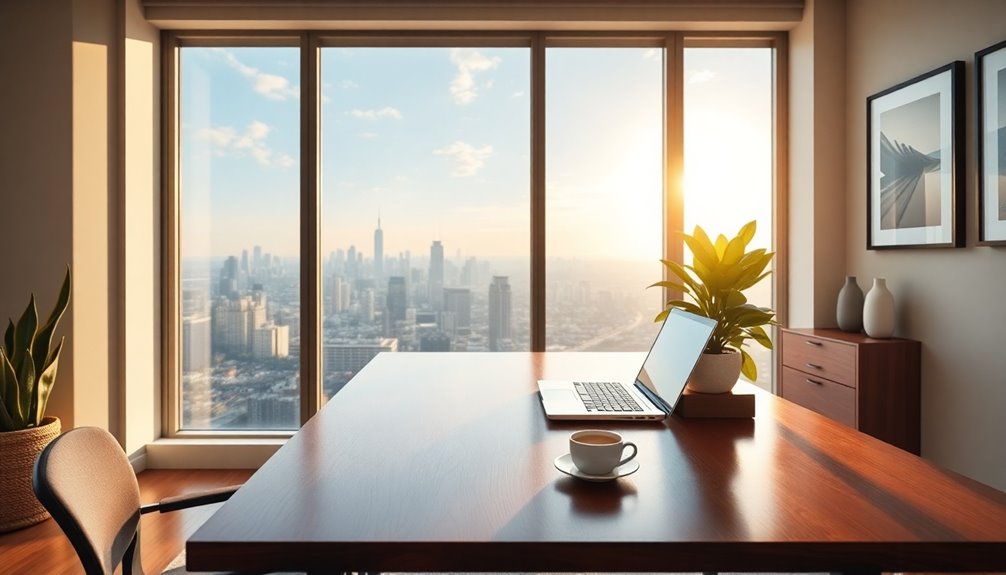
As an expat buyer, you should prioritize work-from-home features when searching for a property. Look for homes with dedicated office spaces and high-speed internet access, as these are essential for productivity. Suburban and rural areas often provide more spacious and affordable options, greatly appealing to remote workers like you. Also, consider the property's layout for versatility between work and leisure activities. Pay attention to natural light and outdoor spaces, which can enhance your well-being. With the right information at hand, you can make an informed choice that supports your work-life balance. There's much more to explore on this topic!
Key Takeaways
- Prioritize homes with dedicated office spaces and high-speed internet to enhance productivity while working from home.
- Consider suburban or rural areas for better affordability and quality of life, detached from urban price hikes.
- Seek properties with flexible floor plans to adapt spaces for both work and leisure activities.
- Research local amenities and community feel, as natural surroundings can improve overall well-being and work-life balance.
- Stay informed on market trends and mortgage options, as low interest rates can significantly impact affordability for expatriate buyers.
Understanding Remote Work Trends
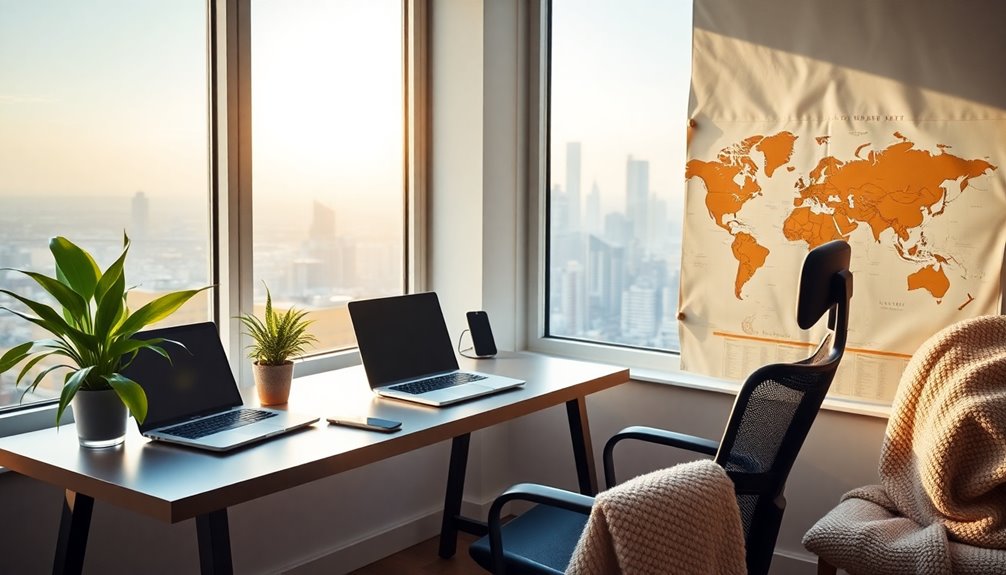
Many people are embracing the shift to remote work, and it's changing how we think about homeownership. Remote work means you can choose where to live without being tied to a specific office location.
This shift towards remote work has greatly impacted home buying trends, with many buyers now prioritizing the needs of remote workers. You're likely noticing increased demand for properties in suburban and rural areas as people seek better quality of life and more space.
As remote work becomes a permanent fixture for many, around 41% of the U.S. workforce is actively looking for homes that can accommodate dedicated office spaces. This has led to rising property prices in these sought-after regions, as buyers recognize the importance of a comfortable and functional workspace at home.
Key industries like IT, marketing, and accounting are driving this trend, as they adapt to new working paradigms. The desire for remote work flexibility is evident, with 98% of workers expressing a preference for it. Understanding investment strategies can help you make informed decisions when steering through the evolving real estate market, ensuring you find a home that meets your needs in this new era.
Evaluating Home Features
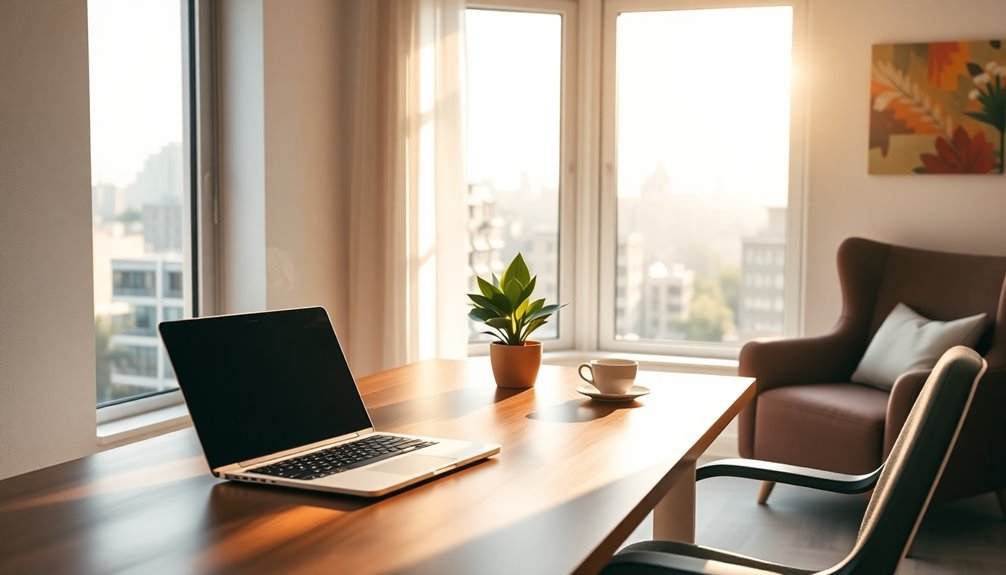
When evaluating home features, it's essential to focus on what'll truly enhance your remote work experience.
As an expat property buyer, you'll want to prioritize elements that support both productivity and comfort. Here are four key features to bear in mind:
- Home Office Space: A dedicated office area is fundamental for maintaining focus and separating work from leisure.
- High-Speed Internet Access: Reliable connectivity is non-negotiable, especially with 93% of employers planning remote job interviews.
- Flexible Floor Plan: Look for homes that offer flexible living spaces, so you can adapt your environment for work and relaxation seamlessly.
- Natural Light and Outdoor Spaces: Properties with ample natural light boost productivity and overall well-being.
Additionally, larger outdoor areas can greatly enhance your work-life balance.
Geographic Considerations for Buyers
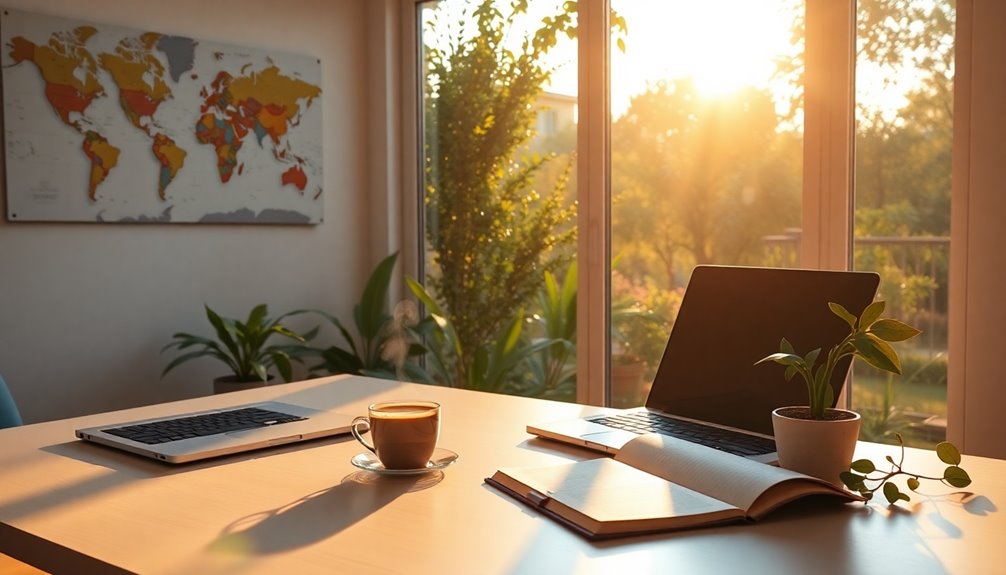
Embracing the freedom that remote work offers, expatriate buyers are redefining where they choose to live. With the traditional need to be close to job centers diminished, many are looking toward suburban areas and even rural locations. This shift prioritizes quality of life, as around 41% of remote workers seek regions with natural amenities and a strong community feel. For expatriate buyers, the appeal of rural living advantages such as lower cost of living, larger plot sizes, and access to outdoor activities are proving to be major draws. Additionally, the opportunity to escape the hustle and bustle of urban life and enjoy a slower pace is enticing for many remote workers. As a result, real estate markets in these areas are experiencing a surge in demand, with properties selling at a faster rate than ever before.
You'll find that many expatriate buyers are gravitating towards affordable housing options, allowing them to enjoy spacious environments while leveraging urban salaries. This geographic flexibility permits you to evaluate places that may have once been overlooked, greatly altering home-buying patterns.
However, be aware that the rise in remote work has intensified competition for properties in desirable locations. First-time buyers often struggle to compete against cash offers from relocating remote workers, making it vital to act decisively.
As you explore options, keep in mind that the current market trends can vary greatly by region, so thorough research is essential. Ultimately, finding the right balance between your lifestyle preferences and housing affordability is key to making a successful purchase in today's dynamic environment.
Financial Implications of Home Buying

Understanding the financial implications of home buying is essential for expatriate buyers maneuvering today's market. As you explore investing in a new home, consider these key factors:
- Interest Rates: Low rates enhance affordability, making it an opportune time for expat buyers.
- Home Prices: Rising home prices in suburban areas reflect the increasing demand from remote workers seeking long-term living solutions.
- Financial Planning: Take currency exchange rates and your home country's economic fluctuations into account when budgeting for your property abroad.
- Prequalifying for a Mortgage: This step will clarify your financial situation, helping you understand what you can afford and preventing financial strain.
With approximately 41% of remote workers in the U.S. desiring permanent arrangements, the trend influences home buying decisions. Additionally, evaluating your investment potential in the context of a Gold IRA can provide valuable insights into safeguarding your financial future.
Evaluating your investment potential is vital—balancing affordability with your long-term goals will lead to a more satisfying purchase.
Adapting to Market Changes
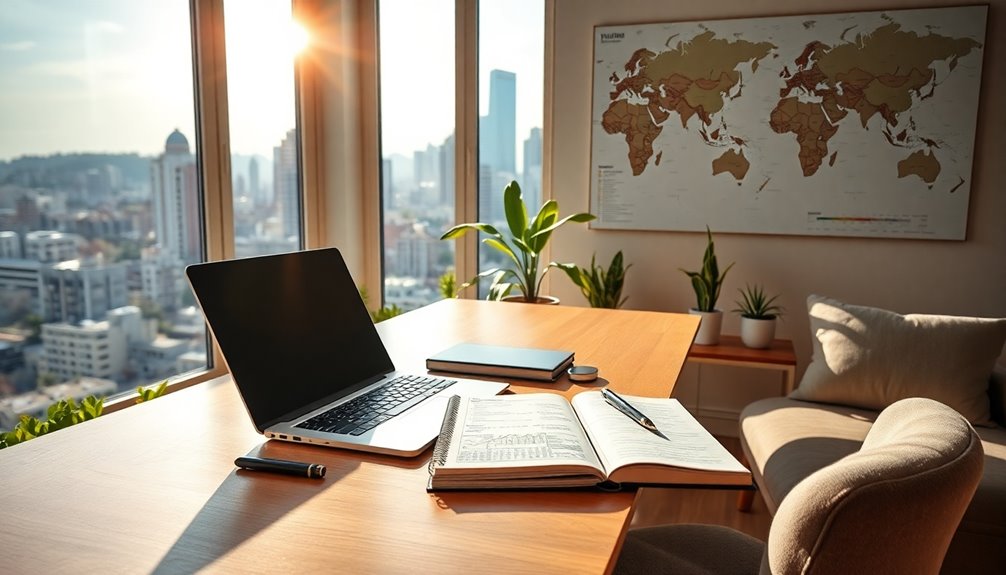
Adapting to market changes is essential for expat property buyers maneuvering today's evolving landscape. With remote work becoming a staple, you're likely prioritizing homes with dedicated office spaces and high-speed internet access.
This shift in housing preferences has led many expats to seek suburban properties, where affordability and an improved quality of life are more attainable compared to urban centers.
As you navigate these market dynamics, keep an eye on rising property prices in desirable areas. Utilize virtual tours and digital marketing strategies to explore potential homes remotely, making informed decisions from wherever you are.
Many expat buyers now prefer communities that offer a blend of recreational amenities and strong local connectivity, enhancing their work-life balance. Engaging in self-care practices can also help maintain well-being during the property search process.
Stay informed about how remote work trends continue to redefine living locations. By understanding these shifts, you'll be better positioned to find a property that not only meets your professional needs but also aligns with your lifestyle preferences.
Embrace the evolving market, and you'll discover the right home that fits your unique circumstances as an expat buyer.
Frequently Asked Questions
How Will Remote Work Affect Real Estate?
Remote work's reshaping real estate in significant ways.
You'll notice a rising demand for larger homes with dedicated office spaces, as more people seek environments that support their work needs.
Suburban and rural areas are becoming more appealing, driving up interest and prices outside urban centers.
High-speed internet and flexible layouts are now essential features in listings, reflecting the shift in how and where you're looking to live and work.
Can I Do My Work From Home Job in Another Country?
Yes, you can absolutely do your work-from-home job in another country!
With the rise of remote work, many companies now support employees working from various locations. As long as you've got reliable internet and a suitable workspace, you're good to go.
Just check your employer's policies on international work and verify you understand any tax implications.
Enjoy the flexibility of blending work and travel while experiencing life in a new country!
What Is Your Biggest Concern About Working Remotely?
Imagine sitting alone in a sunlit room, your laptop open but the silence is deafening. Your biggest concern about working remotely might be that isolation creeping in, leaving you feeling disconnected.
While you enjoy the flexibility, you miss those spontaneous office conversations that spark creativity. You crave a sense of community, where collaboration flows naturally.
Balancing productivity with a fulfilling social life becomes essential, and that's where remote work's challenges begin to surface.
Can You Live Anywhere if You Work From Home?
Yes, you can live almost anywhere if you work from home!
With the rise of remote work, you've got the freedom to choose your ideal location, whether that's a bustling city or a quiet rural area.
Just make sure you've got reliable internet and a comfortable workspace.
Many people are moving to places with a better quality of life, so consider what amenities and community feel are important to you.
Conclusion
As you commence your expat property journey, remember that home is where your Wi-Fi connects automatically. Embrace the freedom remote work offers, but don't forget to reflect on the features and location that'll best suit your lifestyle. Keep an eye on the changing market, and let your financial strategy guide you. By blending practicality with a dash of adventure, you'll not only find a house but a true home in your new corner of the world.
Buying Property Abroad
Education Options Near Popular Expat Property Markets
Selecting the right education options near popular expat property markets can be challenging; uncover the best pathways for your family’s future.

When choosing education options near popular expat property markets, you have several paths. Local schools offer cultural immersion, while private international schools provide continuity with familiar curricula. Local private schools can be more affordable without sacrificing quality. Consider factors like curriculum quality, class size, and teacher qualifications when selecting a school. Also, keep financial implications in mind, such as tuition fees and additional costs. Engaging with expat families can give you valuable insights into school options. Explore the unique education landscape, and you’ll discover the best solutions for your family’s needs. Additionally, when considering education options near popular expat property markets, it’s important to also take into account rental income opportunities. Some families purchase property with the intention of renting it out when they are not using it, which can help offset the cost of education and other expenses. It’s worth researching the rental market and speaking with local real estate professionals to understand the potential for rental income in the area. By considering both education and rental income opportunities, you can make a well-informed decision about where to invest in property.
Key Takeaways
- Local schools offer cultural immersion and language practice, enhancing children's adaptation in popular expat markets.
- Private international schools provide continuity with U.S. curricula, ideal for families relocating frequently.
- Local private schools are often more affordable while maintaining quality education, especially in regions like Latin America and South Africa.
- Homeschooling and flexi schooling options can be tailored to meet individual family needs while navigating local education systems.
- Networking with expat families helps gather insights on school quality, available scholarships, and community integration opportunities.
Understanding School Options
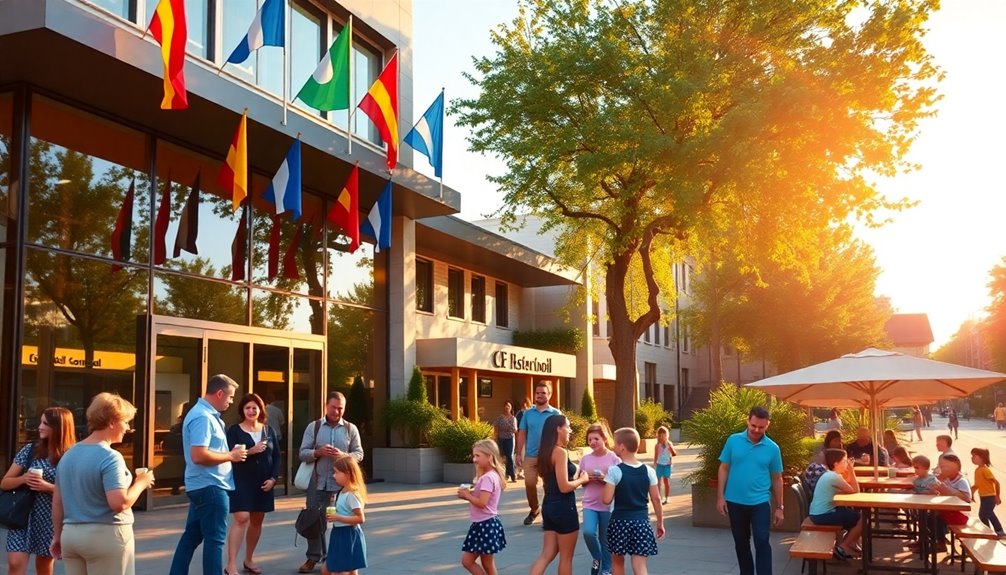
When maneuvering through the maze of educational choices, expat families find themselves weighing various school options that cater to their unique needs.
You'll encounter local schools, which offer cultural immersion and language practice, providing a rich experience for your children. Alternatively, private international schools often follow U.S. curricula, ensuring familiarity and continuity in education, especially during frequent relocations.
If you're budget-conscious, consider local private schools, as they may deliver high-quality education at a lower cost than international schools, particularly in regions like Latin America and South Africa.
For more flexibility, homeschooling allows you to tailor your child's education, although it does require discipline and can limit social interactions.
When exploring these options, pay close attention to the accreditation status of each school. Recognized accreditations can make changes smoother for your children, whether they're moving between schools or preparing for college applications.
Key Factors for Selection

Choosing the right school for your expat children hinges on several key factors that can considerably shape their educational journey. As an expat family, you'll want to prioritize aspects like curriculum quality, teacher qualifications, and class size—these elements directly impact your children's learning experience.
| Factor | Importance |
|---|---|
| Curriculum Quality | Guarantees a solid educational foundation |
| Teacher Qualifications | Affects teaching effectiveness |
| Class Size | Influences individual attention and support |
| Language Support Services | Aids non-native speakers in adapting |
| Extracurricular Activities | Enhances social integration and friendships |
Furthermore, when considering private schools, check their accreditation status. This status guarantees that the institution meets recognized educational standards, easing your children's shift to other schools or even back to the U.S. In addition, proximity to quality international schools can elevate property values, making homes near these institutions more desirable in popular expat markets. By focusing on these key factors, you'll set your children up for a successful and fulfilling educational experience abroad.
Importance of Accreditations
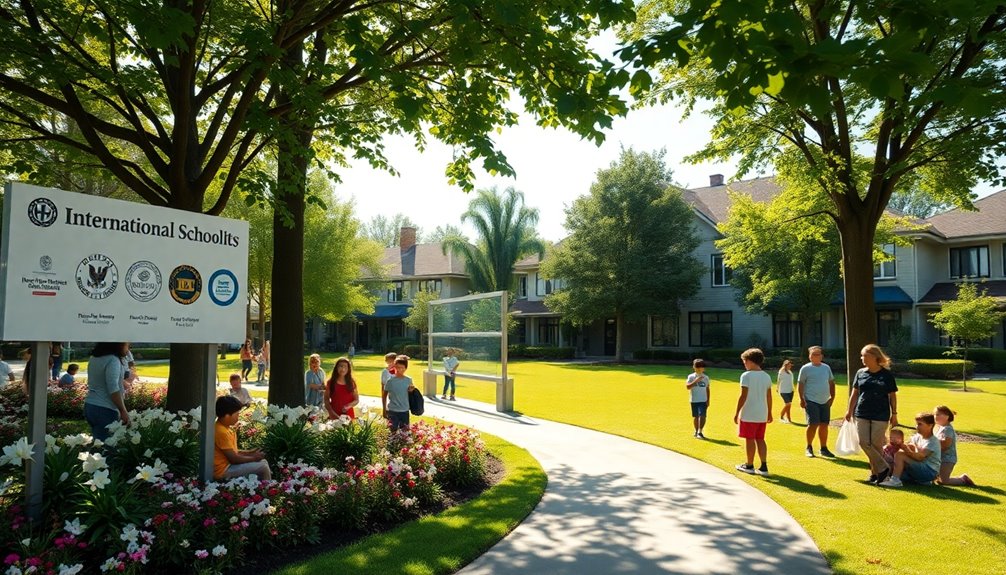
Accreditations play an essential role in ensuring your children's educational experience abroad meets recognized standards. For expat students, understanding the accreditation status of international schools is fundamental for maintaining educational quality and facilitating future school transfers.
Here are three key reasons why you should prioritize accreditation:
- Future Transfers: Confirmed accreditations simplify the process of shifting between schools, ensuring your child's academic record is recognized elsewhere.
- College Opportunities: Many universities require a certain level of accreditation for admission. Knowing your child's school is accredited enhances their chances of acceptance into reputable colleges.
- Quality Assurance: Utilizing resources like the Council of International Schools and the CHEA database can help you verify the educational quality of international schools, ensuring they meet acceptable standards.
Direct contact with schools to confirm their accreditation, especially for U.S. schools, is essential for maintaining educational continuity and ensuring eligibility for FAFSA.
Investigating accreditation through the International Network for Quality Assurance Agencies also provides additional insights into schools' credibility.
Insights From Other Expats

Finding the right educational path for your children often means looking beyond accreditation alone. Many expats share that local schools can greatly enhance cultural integration while providing essential language immersion opportunities.
Connecting with other expat families in your area can give you invaluable insights into the quality and reputation of both international and local school options.
Joining social media groups focused on expat life is another excellent way to gather advice about schooling. You'll discover hidden gems and potential pitfalls in the local education systems.
Feedback from fellow expats indicates that visiting schools and talking directly with teachers and administrators often reveals more about the environment and educational quality than official ratings ever could.
Additionally, expat communities frequently swap information about scholarships or financial aid opportunities available at both international and local schools. This can help you manage educational costs while ensuring your children receive a high-quality education.
Professional Educational Guidance
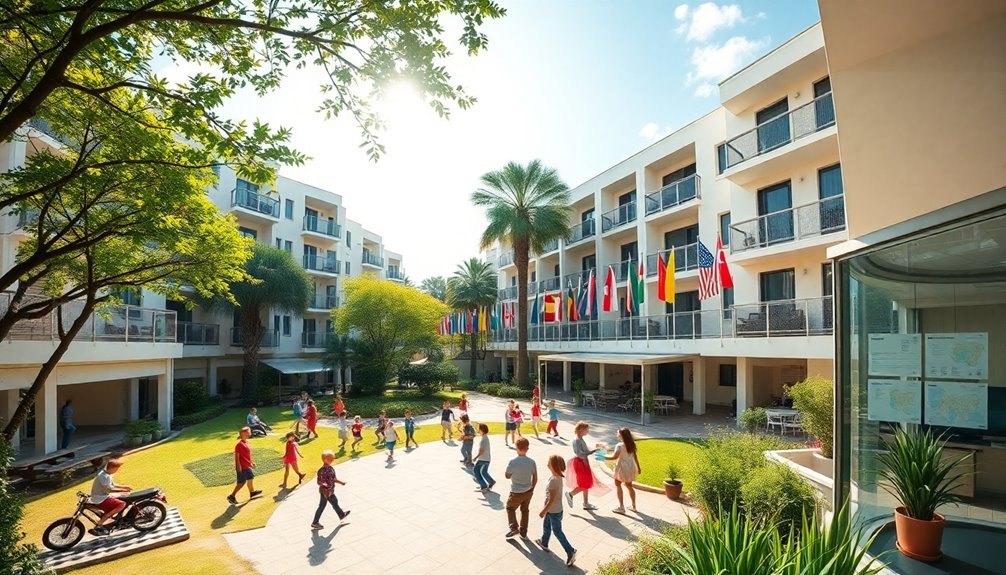
When traversing the educational landscape as an expat, professional educational guidance can be a game changer for your family. Tailored advice from experts can help you navigate the complexities of local education systems, ensuring that your expat children receive the best possible education.
Here's how professional guidance can support you:
- Personalized Insights: Advisors can evaluate various schooling options based on your family's unique needs and preferences, helping you find the right fit for your children.
- Informed Decision-Making: Access to extensive resources and information allows you to explore multiple educational pathways, ensuring you're well-equipped to make informed choices.
- Stress Reduction: Engaging with professionals in expatriate education alleviates the stress of relocating and adapting to new academic environments, making the change smoother for your family.
Utilizing professional educational guidance not only enhances the likelihood of securing quality education options for your expat children but also aligns with your long-term academic and personal goals.
Financial Considerations
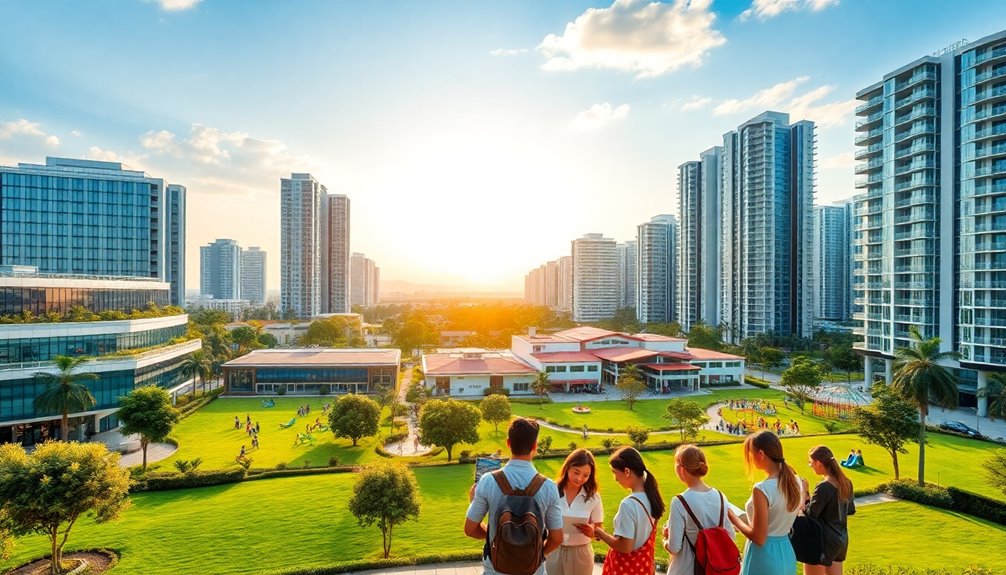
Maneuvering the financial landscape of expat education can be challenging, but understanding the costs involved is essential for budgeting effectively. Tuition fees for international schools can soar over $20,000 annually, while local private schools often provide quality education at more affordable rates.
It's vital to research the options available in your area to make informed decisions.
Don't forget to factor in additional education expenses, such as transportation, books, and school supplies, which can add another 10-15% to your total annual costs. Many schools offer financial aid and scholarships, which can greatly ease the financial burden, especially in high-cost regions.
When budgeting, also consider the tax implications of using 529 education savings accounts abroad. These accounts might be treated as ordinary taxable accounts outside the U.S., which could affect your overall financial strategy.
Finally, keep an eye on fluctuating currency exchange rates, as they can impact tuition fees and other education expenses when paid in local currencies.
Supporting Emotional Well-Being

Supporting your child's emotional well-being during an expat move requires proactive involvement and understanding.
As you navigate this change, focus on fostering resilience and connection. Here are three effective strategies to support your expat children:
1. Encourage Open Communication****: Talk to your kids about the move and the feelings that come with it.
By addressing their concerns, you help them feel secure and validated.
2. Get Involved in Local Clubs****: Encourage your children to join local clubs or sports teams.
These activities create opportunities to make new friends and integrate into the community, enhancing their emotional well-being.
3. Participate in Community Events****: Engage in local community events that celebrate your home culture.
This connection to familiar traditions can instill a sense of belonging amidst the changes.
Transitioning to a New Culture
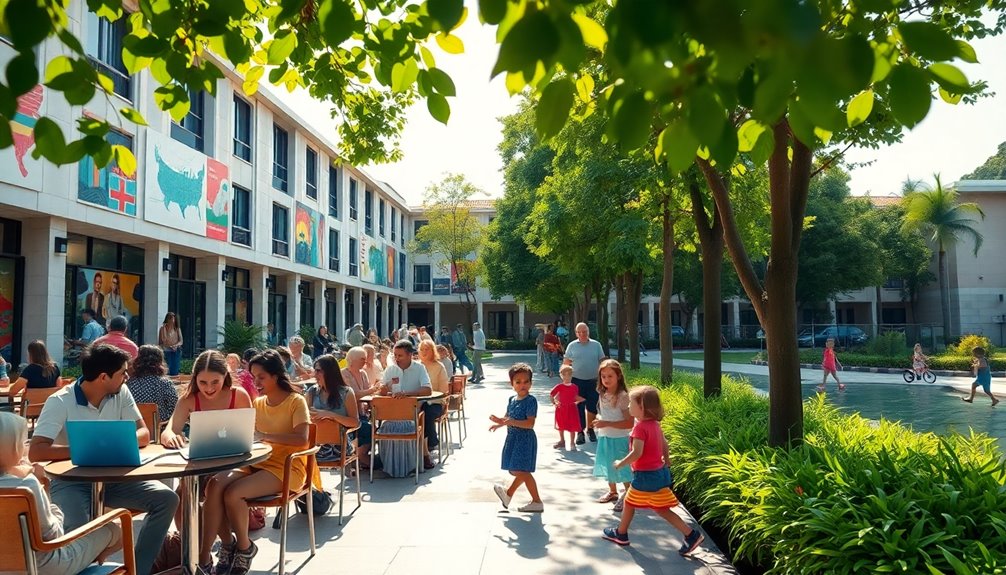
Adapting to a new culture can feel overwhelming, but understanding the local customs and social norms makes the process smoother. For families living abroad, researching the local culture is vital for effective acclimatization. It helps you navigate your new environment with greater ease and confidence.
Learning the local language can be a game-changer, enhancing your communication skills and fostering deeper connections within the community. Consider enrolling in language classes or participating in local immersion experiences.
Building a support network with other expats can also provide invaluable emotional assistance and practical tips during this shift. Such relationships can make adapting to a new culture feel less isolating.
Involving your children in discussions about the move can ease their emotional adjustments, making them feel more secure and engaged in the process.
Participating in local activities, like clubs or sports teams, encourages cultural integration and helps form friendships, which are essential for a successful adjustment.
Explore education options that align with your family's needs, as these can provide additional support during your journey into a new culture. Embrace the change, and soon, you'll find yourself feeling at home in your new environment. Additionally, adopting stress management techniques can significantly aid in maintaining emotional balance during this transition.
Homeschooling Alternatives
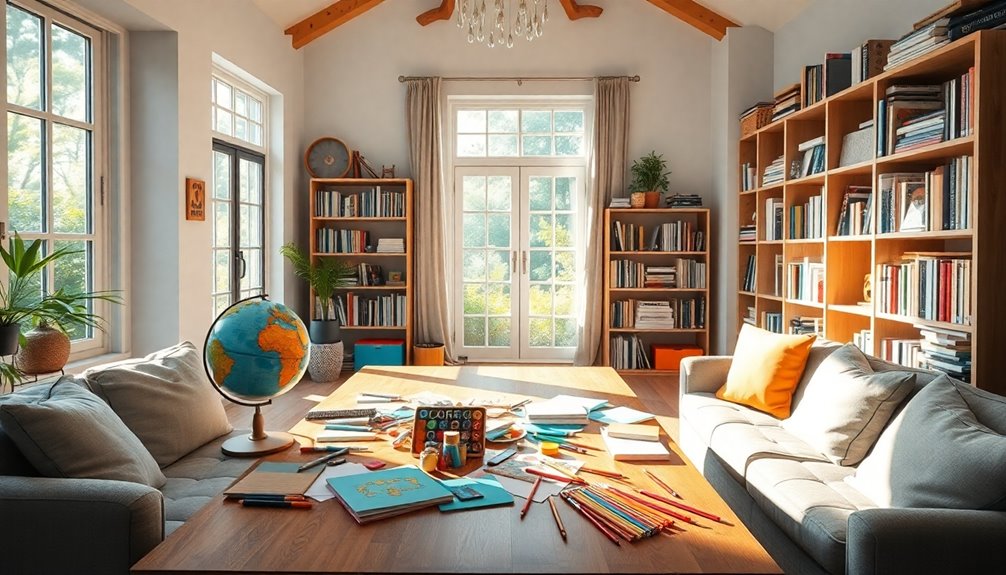
While maneuvering the complexities of expat life, many families are exploring homeschooling alternatives as a flexible education option.
With over 50,000 children in the UK engaged in home education, it's clear that this choice is gaining traction.
If you're considering this route, here are three popular options:
- Homeschooling: You can create a tailored curriculum that meets your child's needs, guaranteeing a personalized learning experience.
- Flexi Schooling: This approach combines part-time homeschooling with traditional schooling, providing flexibility to balance both worlds effectively.
- Customized Homeschooling: Particularly beneficial for children with special education needs (SEN), these programs confirm that learning is adapted to your child's unique requirements.
Before diving in, remember to research the legal requirements for homeschooling in your country.
Engaging with your local education authority is essential, as rules can vary considerably by region.
This knowledge will help you navigate the regulations and guarantee a smooth changeover for your family.
Frequently Asked Questions
What Are the Language Requirements for Local Schools?
Language requirements for local schools often depend on the country and region.
You'll typically find that schools expect proficiency in the local language, especially for younger students.
Some international schools offer bilingual or English-language programs, which might ease your shift.
Be prepared to provide proof of language skills or take an assessment.
It's best to research specific schools to understand their requirements and support systems for non-native speakers.
How Do School Holidays Differ Between Local and International Schools?
School holidays can vary considerably between local and international schools.
Typically, local schools follow national holidays and have longer summer breaks, while international schools often align their calendar with their home country's schedule.
You might find that local schools have shorter breaks throughout the year, while international schools may offer more frequent, but shorter, vacations.
It's crucial to check each school's specific calendar to plan your family's schedule effectively.
What Extracurricular Activities Are Typically Available?
Extracurricular activities often vary widely, but you'll typically find options like sports, arts, music, and drama.
Many schools offer clubs focused on science, technology, or languages, allowing you to explore your interests further.
You might also encounter community service programs, which help develop a sense of responsibility.
Make sure to check with local schools to see what specific activities they provide, as this can enhance your overall educational experience.
How Can I Assess the Quality of a School?
To assess the quality of a school, start by researching its accreditation and reputation.
Visit the school's website to review their curriculum and extracurricular offerings. Talk to parents and students for firsthand insights.
Check out online reviews and ratings, but consider the source. Ultimately, visiting the school can give you a feel for the environment and culture.
Trust your instincts—if it feels right, it might be a great fit for you.
Are There Support Services for Children With Special Needs?
When it comes to support services for children with special needs, you'll find a variety of options available.
Many schools offer specialized programs that cater to individual learning requirements. You should inquire about their resources, like speech therapy or counseling, which can make a significant difference in your child's development.
After all, every child deserves the right support to thrive, don't they?
Conclusion
Charting education options in popular expat markets can feel like wandering through a maze, but with the right guidance, you can find the best path for your child. By considering factors like accreditations, emotional well-being, and cultural changes, you'll set them up for success. Remember, you're not alone in this journey—many expats have walked the same road. Embrace the adventure and make informed choices that will help your family thrive in a new environment.
Buying Property Abroad
Designing Your Dream Expat Home: Local vs. International Styles
Master the art of blending local and international styles in your expat home to create a unique sanctuary that truly reflects your identity. Discover how!
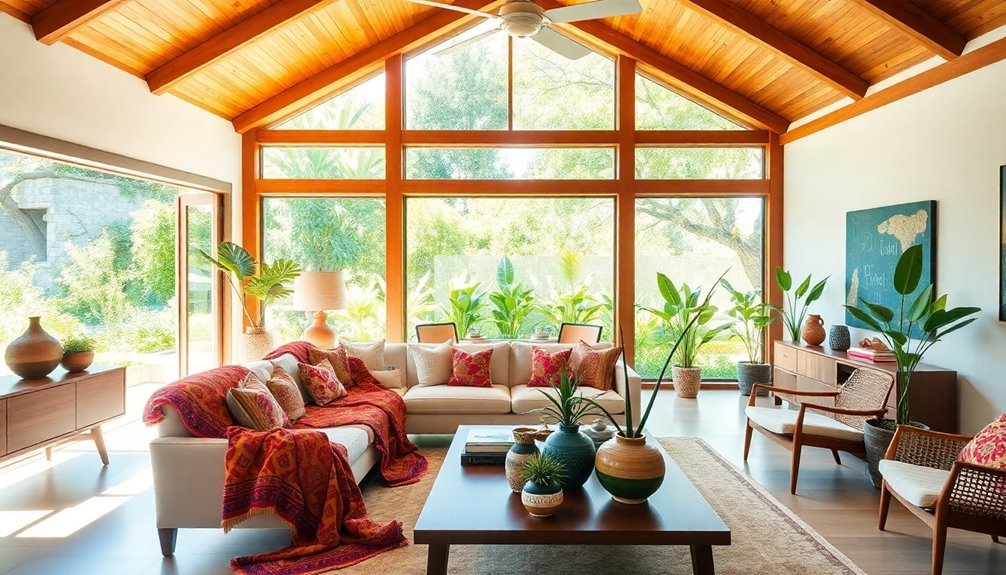
When designing your dream expat home, blend local styles with international elements to create a unique space that reflects your identity. Incorporate local materials and engage local artisans to add authenticity and community connection. Use familiar artifacts from your home country to spark conversation and warmth. Consider multi-purpose furniture and efficient storage to enhance functionality while maintaining style. Emphasizing a cohesive color palette can unite different cultures harmoniously. By balancing personal heritage with regional influences, you'll not only enrich your living space but also your cultural experience. Discover the best ways to achieve this balance for your new home.
Key Takeaways
- Embrace local materials to enhance aesthetics and foster a sense of belonging in your expat home while respecting architectural heritage.
- Integrate personal artifacts from your home country to spark conversations and reflect your unique identity within the local culture.
- Support local artisans for distinctive decor items that deepen your connection to the community and enhance the authenticity of your living space.
- Blend culinary traditions by preparing familiar dishes with local ingredients, creating a narrative that reflects your cultural fusion.
- Establish a cohesive color palette that harmonizes elements of both local and international styles, promoting a seamless integration in your home design.
Understanding Expat Home Design
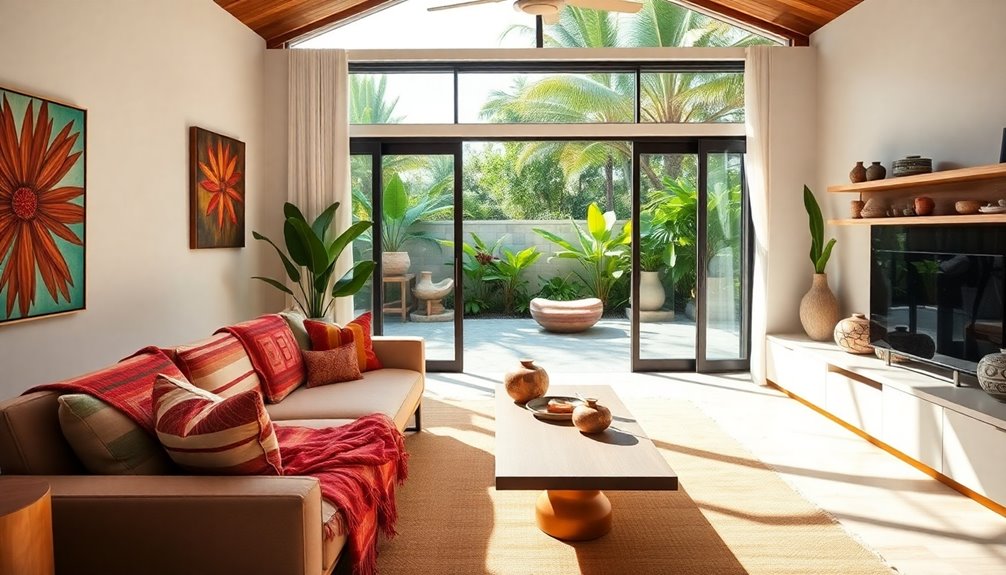
When it comes to designing your expat home, the essence of identity plays an essential role. You'll find that blending local materials with your personal heritage creates a unique space that reflects both your journey and the different culture around you. This integration not only honors your roots but also immerses you in the host country's vibe.
Incorporating elements from the local environment can enhance your sense of belonging. Think about engaging with local artisans to source decor items that showcase the craftsmanship of your new home. These unique pieces don't just beautify your space; they also connect you to the community and foster appreciation for the culture.
You might also want to merge familiar elements from your home country, whether through personal artifacts or culinary traditions. This mixture can create a comforting atmosphere while serving as a conversation starter among diverse backgrounds in expat communities. Additionally, consider integrating authentic Indigenous art to celebrate the rich heritage of local cultures, further enriching your living environment.
Mindfully designed spaces reflect both local aesthetics and your international experiences, ultimately enriching your living environment and deepening your connection to the place you now call home.
Importance of Local Influences
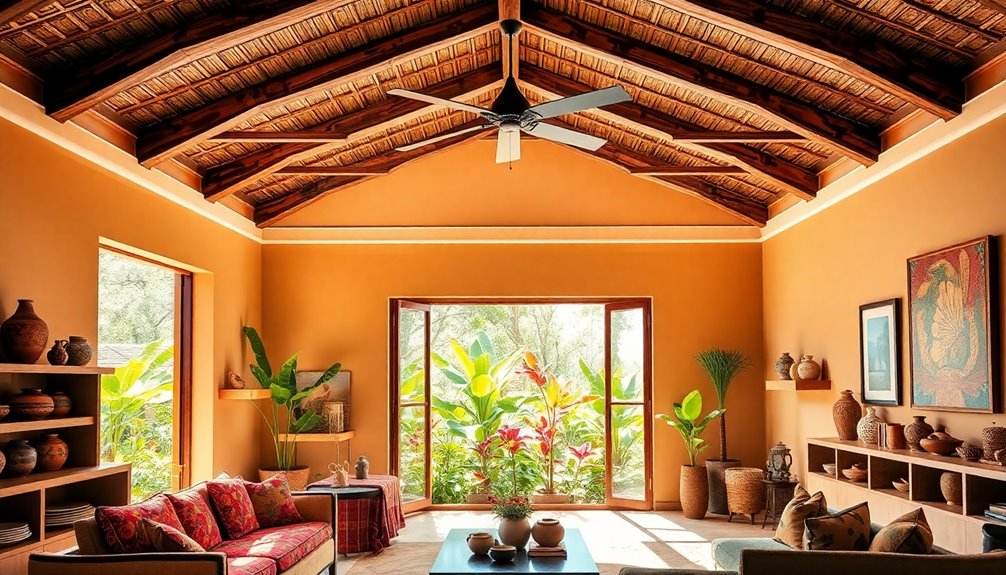
Local influences are essential in shaping your expat home, as they create a rich tapestry that connects you to your new surroundings. Incorporating local materials and styles not only enhances the aesthetic appeal but also helps you foster a sense of belonging, which can ease the culture shock you might experience.
By embracing local design elements, you can make practical choices that suit the region’s climate and living conditions, ensuring your home is comfortable and functional. For example, designing homes in tropical climates may include features such as open floor plans, large windows for natural ventilation, and roof overhangs for shade. These elements not only reflect local architectural styles but also help to keep the interiors cool and comfortable. When considering expat home climate considerations, it’s important to take into account the specific needs and preferences of people from different parts of the world, and incorporate design elements that cater to a diverse range of cultural and climatic backgrounds.
Understanding local customs and traditions can inspire unique decor that celebrates the culture and history of your area. Engaging with local artisans and craftsmen not only supports the community but also provides you with distinctive pieces that reflect the region's identity. Additionally, incorporating natural elements like plants and water features can create a tranquil atmosphere in your home.
These personal touches can transform your living space into a harmonious blend of your roots and the local culture, creating a welcoming environment.
Ultimately, prioritizing local influences in your home design will enrich your experience as an expatriate. It allows you to create a space that feels truly yours while respecting and honoring the place you now call home.
Incorporating International Aesthetics
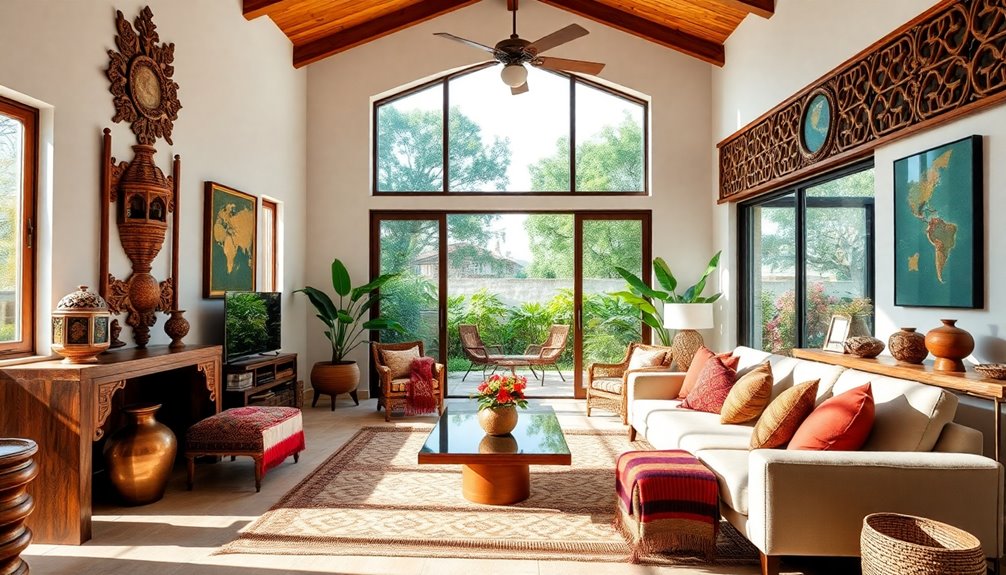
When you think about incorporating international aesthetics into your expat home, consider blending cultural elements that resonate with your personal story.
Using local materials alongside artifacts from your home country creates a space that not only feels authentic but also tells your unique narrative.
Personalized decor touches can transform your living area into a harmonious blend of your roots and your new surroundings.
Blending Cultural Elements
Creating a harmonious blend of cultural elements in your expat home can transform your living space into a vibrant reflection of your journey. By incorporating aspects from both your home culture and your new locale, you celebrate the diversity of your experiences while fostering a sense of belonging.
Consider these ideas to enrich your decor:
| Your Home Culture | Local Culture |
|---|---|
| Personal artifacts | Local crafts and art |
| Childhood tastes in meals | Local cooking traditions |
| Family heirlooms | Traditional textiles |
| Familiar color palettes | Regional architectural styles |
Merging familiar elements with local aesthetics not only creates a unique cultural expression but also serves as a conversation starter. It encourages cultural exchange and appreciation among friends and family. Engaging in local crafts and arts enhances the authenticity of your living space, showcasing your diverse background while allowing you to fully integrate into your new surroundings. Remember, blending cultural elements enriches your experience of living abroad, making your home a true reflection of your hybrid identity. Incorporating natural materials can also enhance the cozy and inviting atmosphere typical of home spaces.
Local Material Choices
Incorporating materials that reflect your new surroundings can greatly enhance your expat home, making it both authentic and visually appealing. By using local materials like stone, wood, and textiles, you pay homage to your host culture's architectural heritage while creating a unique space that resonates with your identity.
Opting for locally sourced materials supports the local economy and promotes sustainability, cutting down on transportation emissions associated with imported goods. Consider blending international aesthetics with these local materials to craft a design that showcases your hybrid identity.
For example, you could combine traditional local craftsmanship with modern design elements, such as sleek furniture made from reclaimed wood. Engaging local artisans can lead to bespoke options that infuse your home with personalized touches, celebrating both the craftsmanship of your new country and your own style. This approach not only enriches your living space but also fosters a deeper connection to your new environment, making your expat home a true reflection of both your past and present.
Embracing local materials is a powerful way to create a harmonious balance between your roots and the culture surrounding you. Additionally, investing in sustainable practices ensures that your design choices contribute positively to both your well-being and the environment.
Personalized Decor Touches
Building on the foundation of local materials, personalized decor touches allow you to express your unique identity while celebrating your experiences as an expatriate.
By incorporating elements from both local and international aesthetics, you create a vibrant environment that reflects your diverse cultural identity. Embrace the challenge of adjusting to new surroundings by adding something new to your decor.
Consider these ideas to enhance your space:
- Artifacts and Souvenirs: Display items from your home country to remind you of your roots and spark conversations with guests about your journey.
- Culinary Blends: Use kitchen decor that merges cooking traditions from both cultures, enriching your culinary experience and connecting you with local customs.
- Mixed Design Styles: Combine different design styles, like Scandinavian minimalism and Mediterranean warmth, to highlight the beauty of cultural diversity in your living space.
Incorporating unique pieces into your decor not only creates a unique ambiance but also fosters a deeper connection to both your host country and your home, making your expat experience even more rewarding.
Balancing Comfort and Style
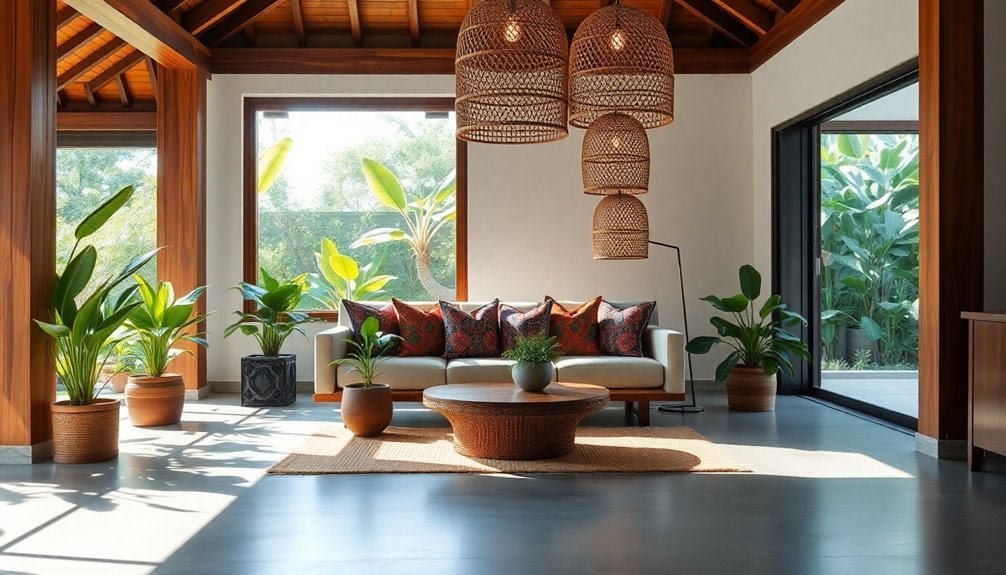
When you're designing your dream expat home, striking the right balance between comfort and style is essential. By incorporating local design elements, you can create a unique living space that reflects both your identity and the culture surrounding you.
Start by blending familiar decor items from home, which can provide comfort and ease feelings of homesickness. Pair these with local materials to enhance the aesthetic appeal of your space.
Utilizing local craftsmanship and art not only supports the community but also sparks conversations and immerses you in the new culture.
Establishing a routine that includes local shopping for home decor can foster a sense of belonging, allowing you to discover unique pieces that resonate with your experiences.
Cultural Artifacts in Home Decor
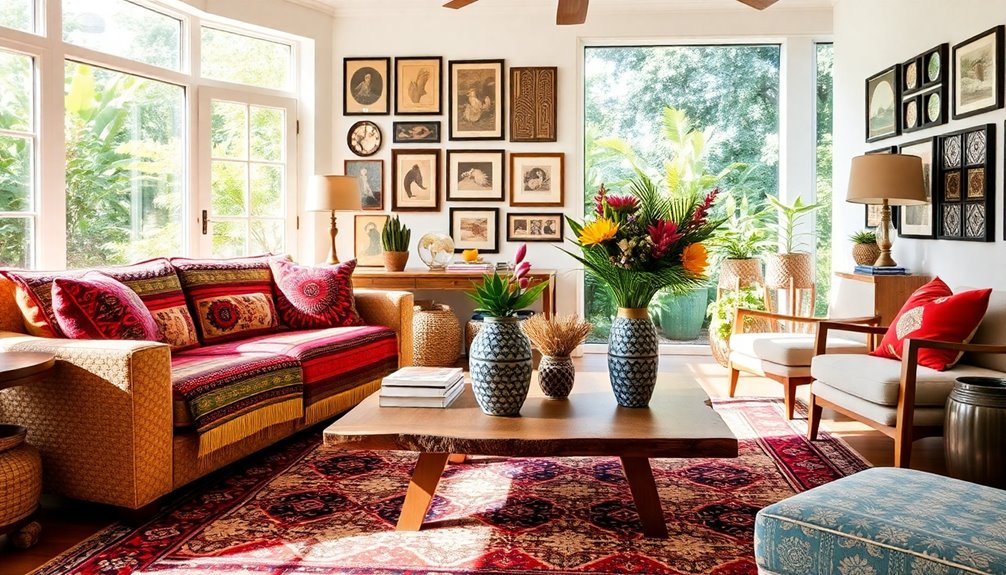
Cultural artifacts can transform your expat home into a vibrant reflection of your journey.
These unique pieces not only showcase the local heritage but also tell your personal story. By incorporating cultural artifacts, you can create a warm and inviting space that resonates with both your roots and your new environment.
Here are three ways to integrate cultural artifacts into your home decor:
- Traditional Pottery: Display handmade pottery from local artisans. Each piece carries a history, adding depth to your decor while supporting the craft community.
- Textiles: Use local textiles for cushions, throws, or wall hangings. These colorful fabrics can infuse your space with warmth and character, making it feel truly unique.
- Artwork: Invest in local artwork or prints that speak to you. This not only beautifies your home but also serves as a conversation starter, helping you connect with locals and fellow expats. Additionally, consider incorporating Indonesian decor masks, which represent rich Indonesian cultural heritage and enhance the aesthetic appeal of your space.
Practical Tips for Blending Styles
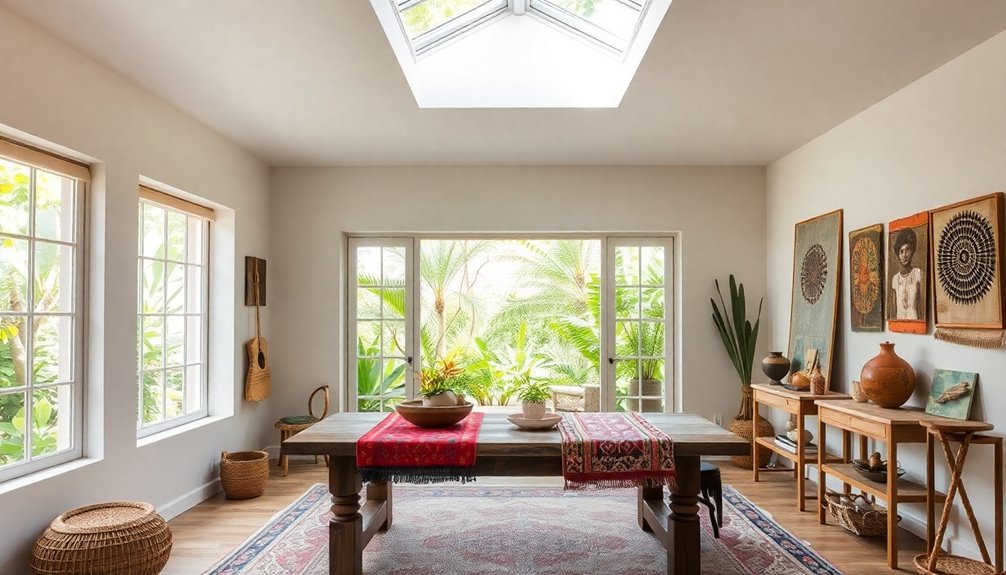
Blending styles in your expat home can create a harmonious environment that reflects both your heritage and the culture of your host country.
Start by incorporating local materials and craftsmanship into your design. This not only celebrates the local culture but also adds a unique aesthetic that's distinctly yours.
Next, use artifacts and decor from both your home country and your host country. This creates a narrative in your space, turning it into a conversation starter and showcasing your diverse background.
Don't forget about your kitchen! Experiment with merging culinary traditions by cooking local dishes infused with familiar flavors from your home country. This fusion can be a delightful way to experience both cultures daily.
Engaging with local artisans and markets is another excellent way to find unique pieces that enhance your home's design while supporting the local economy.
Finally, establish a cohesive color palette that blends elements from both cultures. This promotes harmony in your home, expressing appreciation for the different influences in your life, and ultimately creates a space that feels both welcoming and personal. Additionally, consider incorporating unique planters to add a touch of greenery that reflects both your personal style and the local environment.
Creating a Functional Space
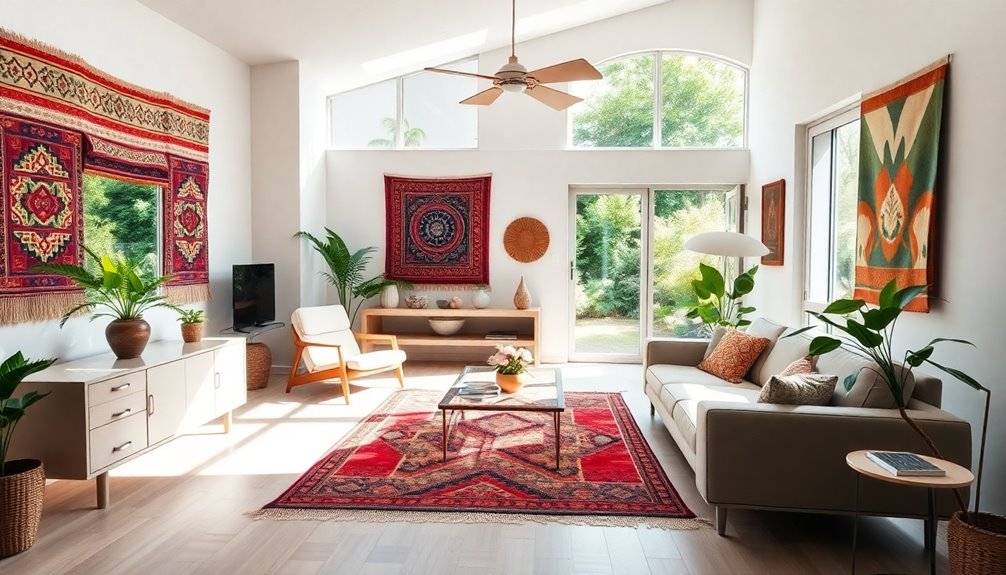
Creating a functional expat home means prioritizing both practicality and aesthetics to enhance your daily living experience.
To achieve this, it's crucial to incorporate local materials and styles that reflect the culture around you. This not only makes your home visually appealing but also functional.
Here are three key strategies to create a functional space:
- Multi-Purpose Furniture: Invest in furniture that serves multiple purposes, especially if your living area is limited. A sofa bed or storage ottoman can maximize your space without sacrificing style.
- Designated Zones: In an open floor plan, establish zones for specific activities. This helps organize daily tasks and improves the overall flow, making your home more functional and efficient.
- Cohesive Storage Solutions: Use storage options that blend seamlessly with local design. This maximizes space while maintaining a cohesive look throughout your home. Additionally, consider implementing vertical storage solutions to free up floor space and enhance organization.
Emotional Connections Through Design
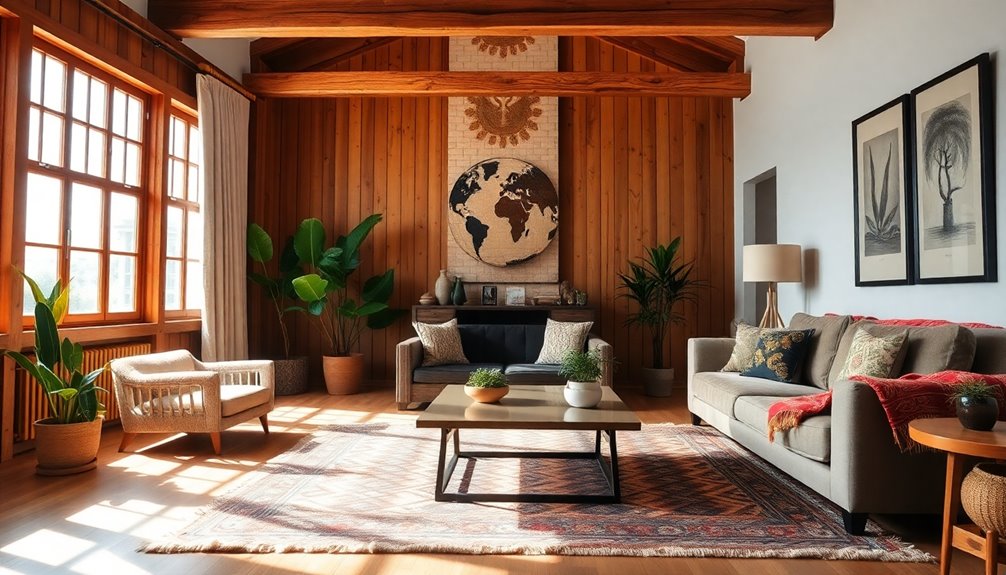
Emotional connections in your expat home can greatly enhance your living experience, allowing you to feel rooted even in a new environment. By incorporating personal treasures and artifacts from your home country, you create a sense of belonging that reminds you of your roots.
Blending local materials and styles with elements from your culture helps you forge a unique living space, celebrating your diverse background.
Consider using familiar colors, patterns, and decor that evoke cherished memories, providing comfort and warmth. These design choices not only preserve your emotional ties to home but also create a welcoming atmosphere for friends and family.
Your expat home can also serve as a conversation starter, inviting storytelling and sharing cultural experiences. This fosters deeper connections with your new community, allowing you to bond over shared experiences and traditions.
Ultimately, designing with emotional connections in mind enriches your environment, making it a true reflection of who you are. Incorporating aesthetic hooks and wall organization can enhance both the functionality and visual appeal of your space.
Embrace the beauty of blending cultures, and let your home be a canvas that honors both your past and your present.
Engaging With Local Artisans
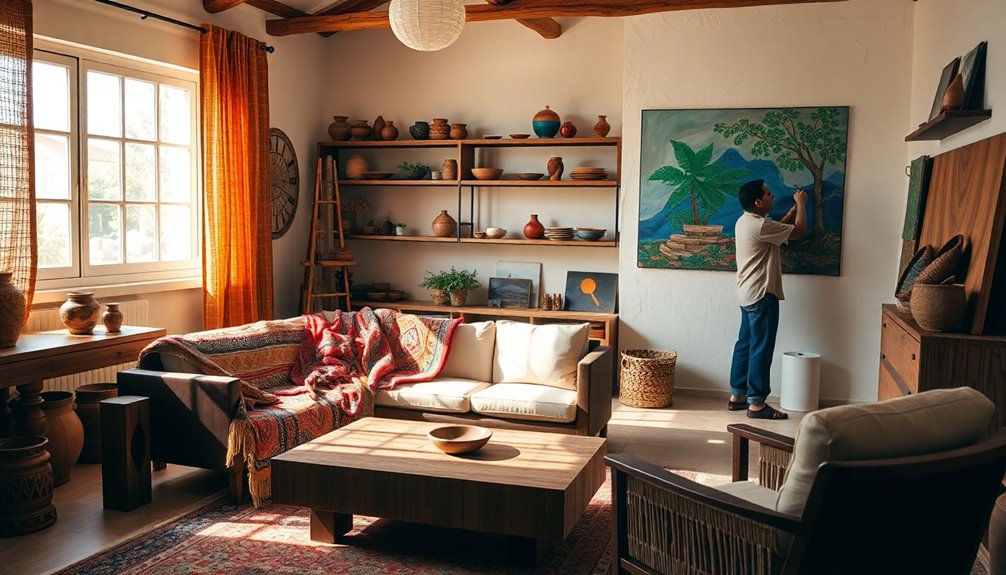
Engaging with local artisans not only brings unique cultural creations into your home but also supports the local economy.
By choosing handcrafted items, you're investing in the community and embracing the rich traditions of your new surroundings.
Plus, you'll get to learn the stories behind these pieces, deepening your connection to their craftsmanship. Additionally, you can explore new regions for undiscovered herbs that might complement your decor or lifestyle.
Supporting Local Economies
When you embrace the vibrant world of local artisans, you not only support the community's economy but also enrich your expat experience.
By engaging with local artisans, you contribute to supporting local economies and help sustain traditional crafts that might be endangered by globalization. This connection allows you to gain unique insights into the culture and practices of your host country.
Here are three ways you can engage with local artisans:
- Shop Locally: Purchase handmade items to enhance your home's authenticity while showcasing your personal style. These bespoke pieces reflect both your taste and the craftsmanship of the local culture.
- Take Workshops: Many artisans offer workshops where you can learn new skills. This hands-on experience deepens your connection to the culture and helps you appreciate the artistry involved in their work.
- Collaborate on Projects: Work with artisans to create custom decor that aligns with your vision while honoring their traditional techniques. This collaboration can lead to unique home pieces that tell a story.
Unique Cultural Creations
Craftsmanship embodies the spirit of a culture, offering expatriates a unique way to connect with their new surroundings. Engaging with local artisans allows you to fill your home with authentic handmade items that reflect both your personal style and the region's heritage. Each piece tells a story, enriching your living space while supporting the local economy.
| Type of Artisans | Unique Creations |
|---|---|
| Potters | Handcrafted ceramics featuring traditional designs |
| Weavers | Custom textiles that showcase regional patterns |
| Woodworkers | Bespoke furniture crafted from local materials |
Collaborating with these artisans can lead to bespoke creations that hold special meaning. Additionally, participating in workshops or classes not only provides a hands-on experience but also deepens your understanding of the culture. By engaging with local artisans, you create unique cultural connections that transform your expat home into a vibrant reflection of your new life. Each item you choose can serve as a conversation starter, bridging the gap between your past and present, while honoring the craftsmanship of your new community.
Personalizing Your Expat Experience
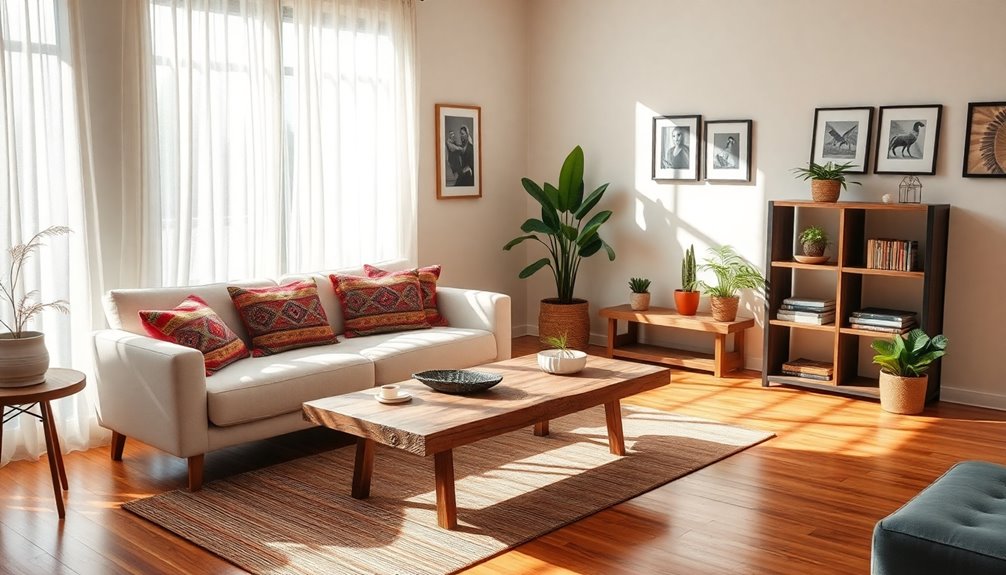
Creating a sense of belonging in your expat home is essential for a fulfilling experience abroad. Personalizing your expat experience not only reflects your identity but also helps you connect with your new surroundings.
Infuse elements from both your home culture and local traditions to create a unique living space. Here are three ways to enhance your expat experience:
- Decorate with Artifacts: Incorporate decor from various cultures. A lot of people find that these items spark conversations with locals and fellow expats, helping build a supportive network.
- Cook Familiar Dishes: Prepare childhood favorites while using local ingredients. This culinary fusion strengthens your ties to both home and your host culture, making every meal an adventure.
- Engage Locally: Establish a routine that includes local activities and community events. Joining local expat groups can make the process of personalizing your home more enjoyable, easing feelings of homesickness.
Frequently Asked Questions
How Can I Find Local Artisans for Home Decor?
To find local artisans for home decor, start by exploring local markets and craft fairs in your area.
You can also ask neighbors or friends for recommendations.
Don't underestimate social media; platforms like Instagram and Facebook often showcase talented local artists.
Websites like Etsy can help you discover artisans nearby too.
Finally, consider visiting art galleries or community centers, where you might connect with skilled individuals passionate about their craft.
What Is the Best Way to Incorporate Personal Items?
Your home's a canvas, and personal items are the vibrant strokes that bring it to life.
To incorporate these treasures, start by choosing pieces that tell your story—photos, souvenirs, or heirlooms.
Arrange them in a way that feels organic, mixing sizes and textures.
Don't shy away from displaying collections; they create conversation.
Are There Specific Colors That Promote a Sense of Belonging?
Colors can greatly impact your sense of belonging.
Warm hues like reds, oranges, and yellows create a cozy, inviting atmosphere, while earthy tones like greens and browns promote a feeling of stability and connection to nature.
Soft blues and pastels can evoke calmness and tranquility, fostering a peaceful environment.
How Do I Balance Modern and Traditional Design Elements?
They say, "There's no place like home," and balancing modern and traditional design can transform your space into just that.
Start by choosing a color palette that bridges both styles. Incorporate contemporary furniture alongside vintage pieces, allowing each to complement one another.
Use traditional patterns in textiles while opting for sleek lines in your decor. By mixing textures and materials, you'll create a harmonious environment that feels both fresh and familiar.
What Are Common Mistakes to Avoid in Expat Home Design?
When designing your expat home, it's easy to make common mistakes.
Don't ignore the local culture; blending in can enhance your experience.
Avoid cluttering your space with too many personal items; it can feel overwhelming.
Don't overlook functionality—ensure your layout suits your lifestyle.
Skimping on quality materials might save money short-term, but it'll cost you later.
Finally, remember to enjoy the process; creating a home should be fun, not stressful!
Conclusion
In designing your dream expat home, remember that blending local influences with international styles can create a unique sanctuary. Did you know that 73% of expats report feeling more at home when they incorporate local elements into their decor? By engaging with local artisans and personalizing your space, you not only foster emotional connections but also embrace your new environment. So, let your home reflect both your journey and the culture around you, making it truly yours.
-

 Making Money Online2 months ago
Making Money Online2 months agoCorinna Kopf Ends OnlyFans Run at 28 with $67M Earnings
-

 Making Money Online3 months ago
Making Money Online3 months agoSenior Writers Can Profit Too: Earn Money by Publishing Your Stories Now
-

 Making Money Online3 months ago
Making Money Online3 months agoMarketing Mastery for Senior Authors: Boost Your Sales With Proven Tactics
-

 Making Money Online3 months ago
Making Money Online3 months agoNow Is the Time to Write: Why Fiction Is the Best Career for Retired Seniors
-

 Lifestyle and Money3 months ago
Lifestyle and Money3 months agoDiscover the Success of Shorter Workweeks
-

 Lifestyle and Money3 months ago
Lifestyle and Money3 months agoDiscover Effective Strategies to De-Stress Today
-

 Making Money Online3 months ago
Making Money Online3 months agoGrow Your Author Community: Engage Readers and Build a Fanbase as a Senior Writer
-

 Lifestyle and Money3 months ago
Lifestyle and Money3 months agoIs a Co-Working Space Right for You

















